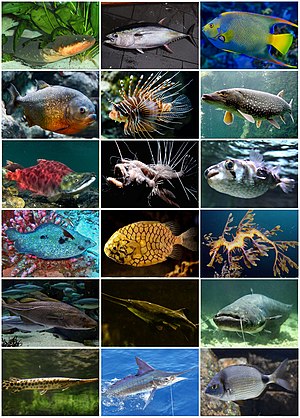
Back Actinopterygii Afrikaans Strahlenflosser ALS شعاعيات الزعانف Arabic شعاعيات الزعانف ARZ Actinopterygii AST Şüaüzgəclilər Azerbaijani شواوزگجلیلر AZB Прамянёвапёрыя рыбы Byelorussian Лъчеперки Bulgarian রশ্মি-পাখনার মাছ Bengali/Bangla
| Ray-finned fish | |
|---|---|
 | |
| Scientific classification | |
| Domain: | Eukaryota |
| Kingdom: | Animalia |
| Phylum: | Chordata |
| Superclass: | Osteichthyes |
| Class: | Actinopterygii Klein, 1885 |
| Subclasses | |
| |
Actinopterygii (/ˌæktɪnɒptəˈrɪdʒiaɪ/; from actino- 'having rays', and Ancient Greek πτέρυξ (ptérux) 'wing, fins'), members of which are known as ray-finned fish or actinopterygians, is a class of bony fish[2] that comprise over 50% of living vertebrate species.[3] They are so called because of their lightly built fins made of webbings of skin supported by radially extended thin bony spines called lepidotrichia, as opposed to the bulkier, fleshy lobed fins of the sister class Sarcopterygii (lobe-finned fish). Resembling folding fans, the actinopterygian fins can easily change shape and wetted area, providing superior thrust-to-weight ratios per movement compared to sarcopterygian and chondrichthyian fins. The fin rays attach directly to the proximal or basal skeletal elements, the radials, which represent the articulation between these fins and the internal skeleton (e.g., pelvic and pectoral girdles).
The vast majority of actinopterygians are teleosts. By species count, they dominate the subphylum Vertebrata, and constitute nearly 99% of the over 30,000 extant species of fish.[4] They are the most abundant nektonic aquatic animals and are ubiquitous throughout freshwater and marine environments from the deep sea to subterranean waters to the highest mountain streams. Extant species can range in size from Paedocypris, at 8 mm (0.3 in); to the massive ocean sunfish, at 2,300 kg (5,070 lb); and to the giant oarfish, at 11 m (36 ft). The largest ever known ray-finned fish, the extinct Leedsichthys from the Jurassic, has been estimated to have grown to 16.5 m (54 ft).
- ^ Zhao, W.; Zhang, X.; Jia, G.; Shen, Y.; Zhu, M. (2021). "The Silurian-Devonian boundary in East Yunnan (South China) and the minimum constraint for the lungfish-tetrapod split". Science China Earth Sciences. 64 (10): 1784–1797. Bibcode:2021ScChD..64.1784Z. doi:10.1007/s11430-020-9794-8. S2CID 236438229.
- ^ Kardong, Kenneth (2015). Vertebrates: Comparative Anatomy, Function, Evolution. New York: McGraw-Hill Education. pp. 99–100. ISBN 978-0-07-802302-6.
- ^ Nelson, Joseph S. (2016). Fishes of the World. John Wiley & Sons. ISBN 978-1-118-34233-6.
- ^ (Davis, Brian 2010).
© MMXXIII Rich X Search. We shall prevail. All rights reserved. Rich X Search